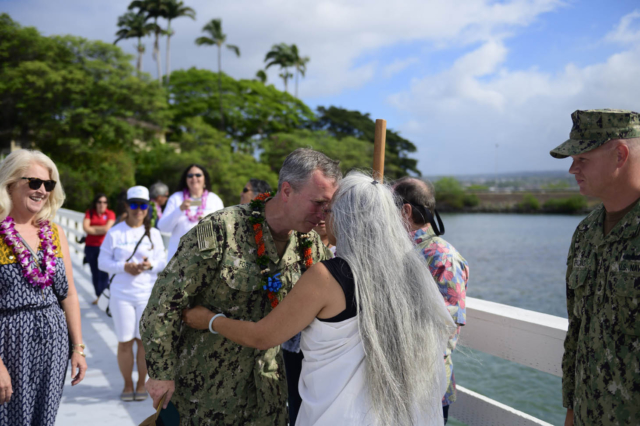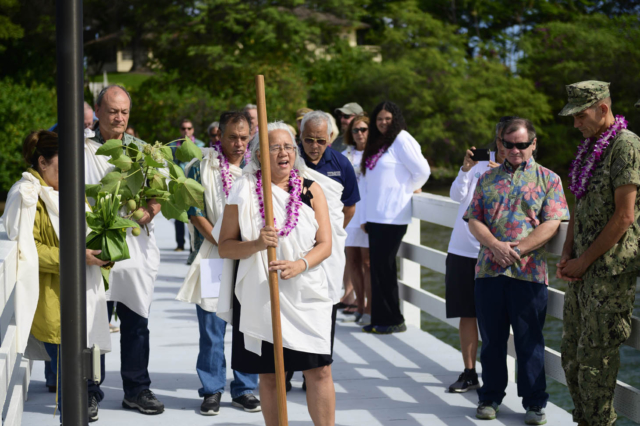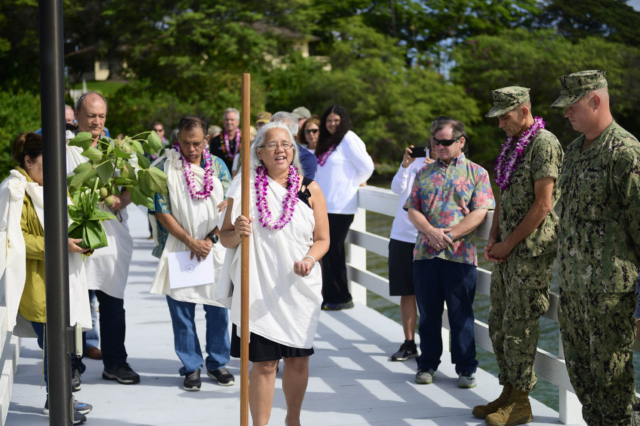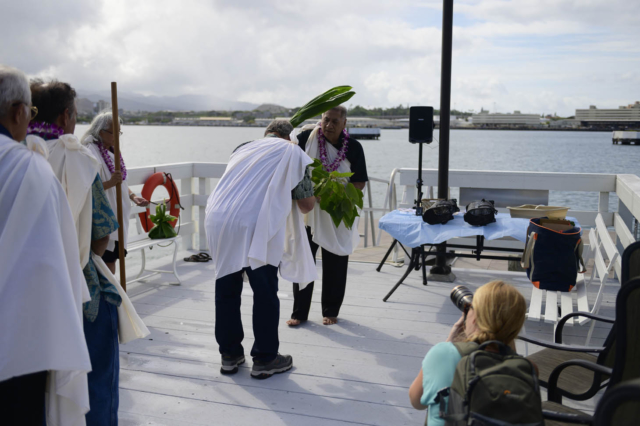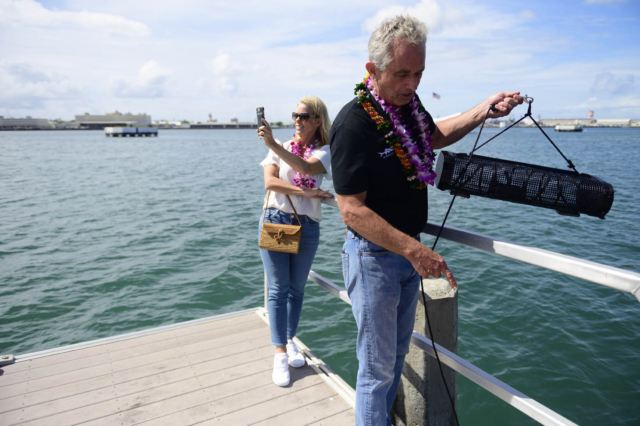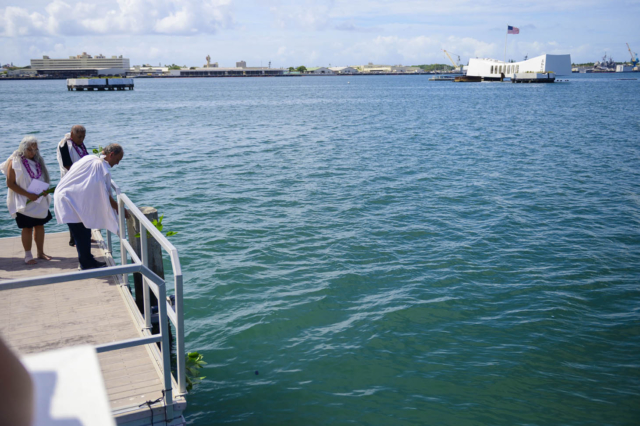
Native Oysters Return to Pearl Harbor
- Posted on 6 Jun 2019
- In Malama Honua, News, Newsletter, Photo Galleries, Teachers, Updates
There is a new restoration effort to mālalma the waters of Puʻuloa (Pearl Harbor) using oysters.
The U.S. Navy, O‘ahu Waterkeeper and the Pacific Aquaculture and Coastal Resources Center have seized on a novel approach using native oysters to mālama our waters here in Hawai’i. Polynesian Voyaging Society (PVS) master navigator Nainoa Thompson was at Pearl Harbor yesterday to help celebrate the kickoff of oyster restoration. Voyagers witnessed first hand the large-scale Billion Oyster Project in New York Harbor in partnership with Hudson Riverkeeper. At yesterday’s event, Nainoa spoke to the value of these partnerships in moving our planet forward. The native oyster project was also mentioned during Hōkūleʻa’s historic first sail into Pearl Harbor in February last year.
The following comes from our friends at the U.S. Navy:
Native Oysters Take a Plunge Into Pearl Harbor
Joint Base Pearl Harbor-Hickam – The first native oysters have taken the plunge into their new home at Pearl Harbor. A ceremonial event yesterday morning on Ford Island. Earlier this year, the U.S. Navy, O‘ahu Waterkeeper and the Pacific Aquaculture and Coastal Resources Center (PACRC) at the University of Hawai‘i at Hilo joined forces to use native species of shellfish to improve water clarity and quality in the Pearl Harbor estuary.

Oyster spat have grown large enough for this opening event that included Hawaiian oli by local Hawaiian practitioners and an official welcome by Rear Admiral Brian Fort, commander of Navy Region Hawaii and Naval Surface Group Middle Pacific. Other key attendees included Polynesian Voyaging Society Master Navigator Nainoa Thompson and Waterkeeper Alliance President of the Board Robert F. Kennedy Jr.
The project, based on a partnership with O’ahu Waterkeepers and PACRC, plans to use two species of oyster native to Pearl Harbor: Dendostrea sandvicensis (Hawaiian Oyster) and Pinctada margaritifera (Black-lip Pearl Oyster). The project builds on the successful feasibility study conducted by the Department of Land and Natural Resources, Division of Aquatic Resources, using a nonnative species, Crassostrea gigas (known as the Pacific Oyster), as a tool to improve clarity and quality of waters within Pearl Harbor.

Native oysters filter between 20 and 45 gallons of water per day depending on their size, removing harmful pollutants including bacteria, heavy metals, oil, microplastics and sunscreen chemicals, improving water clarity and quality. “This project will further the Navy’s environmental stewardship activities in Pearl Harbor and hopefully lead to long-lasting positive effects on the harbor through sustained augmentation of oyster beds,” said Cory Campora, Navy’s natural resources manager.
The oysters produced by the project are for restoration only, not for consumption. Commercially farmed oysters in other near shore areas of Oʻahu are safe to eat because the waters they are grown in are regularly tested by the Hawaii State Department of Health (DOH).
Mahalo for the photos from our friends at the U.S. Navy
Background information on the restoration project itself:
A partnership is now working together to return native Hawaiian oysters to their namesake waters, Pearl Harbor. The Navy, O‘ahu Waterkeeper, and the Pacific Aquaculture and Coastal Resources Center (“PACRC”) at the University of Hawai‘i at Hilo are restoring native oysters to improve water clarity and quality in the waters of Pearl Harbor. Historically, Pearl Harbor’s waters were known as “Wai Momi” or “pearl waters.” Native oysters, and oyster reefs, were once abundant and an integral part of the marine ecosystem and local culture, recorded in history through Native Hawaiian chants, songs, and legends. Pearl Harbor is at the bottom of a drainage system from Aiea to Ewa, catching stormwater and other land-based contaminants. Oysters filter water, removing harmful pollutants including sediment, bacteria, heavy metals, PCBs, oil, microplastics, carbon, and nutrients from the water column.
Today, the Navy, O‘ahu Waterkeeper and PACRC are restoring native shellfish species in honor of their deep cultural significance and in hopes of replenishing these species for future generations. The project will use two species of shellfish native to Pearl Harbor: Dendostrea sandvicensis (Hawaiian Oyster) and Pinctada margaritifera (Black-Lipped Pearl Oyster). “The Navy is to be commended for undertaking this significant initiative while the native species are still thriving in small numbers within Navy waters,” stated Marian Phillipson, Program Director, O’ahu Waterkeepers. “Ultimately, it will be an achievement of our time to return a natural feature to the ecosystem which had been largely lost.”
“There are over 200 species of native bivalve shellfish in Hawaiian waters,” stated Dr. Maria Haws, Director of PACRC. “Many of the previously abundant species are now rare, so we have been working to develop hatchery production methods over the last ten years.” Notably, restoration oysters are not edible. Commercial oysters, which are grown under strict regulations for clean water, are safe to eat.
This initiative is modeled after several successful partnerships with Waterkeeper organizations on the East Coast involving the restoration of native oysters to improve water quality, including the Billion Oyster Project in New York Harbor. Under the direction of Board President, Robert F. Kennedy Jr., Waterkeeper Alliance is a global movement to protect water resources, currently uniting more than 340 Waterkeeper Organizations and Affiliates in over 40 countries. Their mission is fishable, swimmable, drinkable waters. The organization is committed to finding solutions to reduce land-based pollutants and improve water quality. For more information, please visit www.waterkeepershi.org




